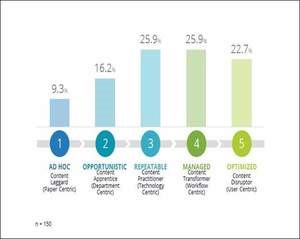To help organizations evaluate current content management infrastructure and capabilities and identify the steps they need to take to advance to the next stage of maturity, IDC developed the IDC MaturityScape for managing enterprise content. IDC has also established a benchmark study on content management maturity to offer a systematic and rigorous approach for organizations to assess their content management competency and maturity. This article provides a high level summary of key findings.
The same technological forces that are driving digital transformation (DX) across organizations of all sizes and industries are also driving significant changes in how those organizations create, manage, and consume business content. Cloud, mobility, and social businesses have engendered an “anytime, anywhere, anyone” paradigm that offers both new opportunities for operational efficiencies and collaboration and new threats to enterprise security and compliance. The sheer magnitude of content in applications and repositories (official and unofficial) offers both the prospect of greater insight through advanced analytics and bigger challenges related to finding and acquiring documents and information.
Content management technologies have also been evolving. Traditional enterprise content management (ECM) solutions have developed into application suites that often include records management, case management, enterprise capture, and content workflow automation capabilities. At the same time, we have seen the migration of file synchronization and sharing (FSS) solutions, many of which began as consumer-centric offerings, into the business environment with the promise of ubiquitous, cross-device access to content and easy sharing across business entities. Many of these solutions are morphing into enterprise-grade solutions that address the control and security needs of IT departments.
The boundaries between content management technologies are evolving, expanding, morphing, merging, modularizing, and blending, but the need for organizations to manage content is more compelling than ever. “Managing” content includes a number of use cases — supporting collaborative content creation, providing a source for analytics and machine learning, and serving as the “single source of truth” within an organization. For these reasons, our IDC’s maturity model and companion benchmark look at managing enterprise content rather than “enterprise content management.”
To effectively manage enterprise content, organizations must recognize and understand their content-centric use cases and the supporting business processes within their own businesses. They must adopt consistent practices for investment and for developing purpose-specific instantiations of content management technologies driven by organizational priorities. This is best accomplished by including content management as a core component in the larger digital transformation initiatives of the organization.
To help organizations evaluate current content management infrastructure and capabilities and identify the steps they need to take to advance to the next stage of maturity, IDC developed the IDC MaturityScape for managing enterprise content. IDC has also established a benchmark study on content management maturity to offer a systematic and rigorous approach for organizations to assess their content management competency and maturity.
IDC MaturityScape Benchmark: Managing Enterprise Content — Maturity Distribution Across the Stages

Key findings of this benchmark study include:
- Very few organizations are without some type of strategy for managing enterprise content, even if that strategy is limited in nature. Most have launched at least a rudimentary content digitization initiative.
- Nonetheless, just over half of organizations are at the middle level of maturity or lower, indicating that there is significant room for growth and development in these organizations.
- Almost one-quarter of organizations have deployed sophisticated, AI-enabled technology to augment content management within the enterprise, though IDC believes that many of those initiatives are early implementations and/or at the proof-of-concept stage.




